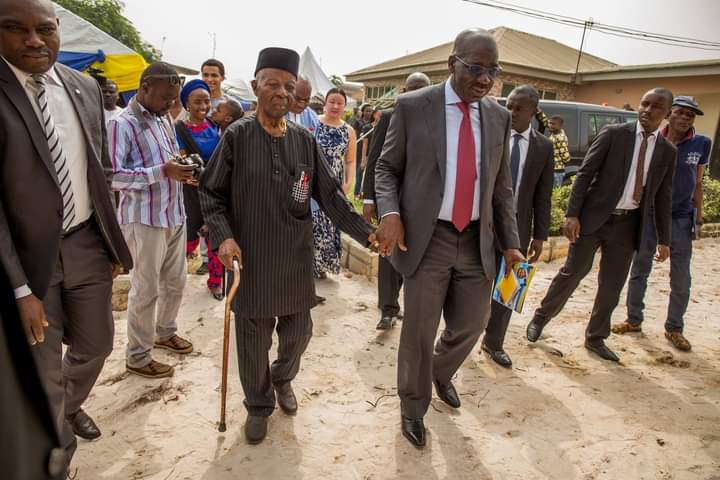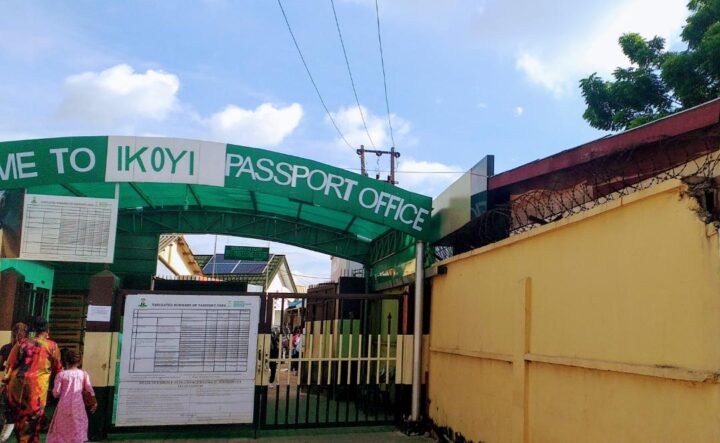Throughout its existence, humanity has found solutions to its many problems, but not a cure for death. On Friday, Nigerians woke up to the news of the passing of Daniel Omoigui, Nigeria’s first surveyor-general of the federation, who was renowned for resolving boundary disputes.
Omoigui breathed his last less than four months after the passing of Akin Mabogunje, Nigeria’s foremost professor of geography, who was instrumental in the mapping of the federal capital territory (FCT).
Omoigui played a crucial role in the establishment of the National Boundary Commission which led to resolving boundary disputes across Nigeria, after the end of the civil war in 1970.
‘STARTED PRIMARY SCHOOL AT AGE 14’
Advertisement
Omoigui was born on November 10, 1931, to the family Egite, in Isi, Uhunmwode LGA of Edo state.
Raised during Nigeria’s colonial era, in an interview to mark his 80th birthday, he said he began primary school at the age of 14.
Speaking on his school days, he added that in 1947, when the government ordered that all the schools in Benin relocate to Asaba, he moved to St. Patrick College (formerly St. Augustine, Asaba) where he received double promotion because of his impressive academic performance. In 1949, he completed his secondary education.
Advertisement
After graduating from secondary school, he took up teaching at the Niger College, Benin, in 1950.
In 1953, he sat for the entrance examination into the University College, Ibadan (now University of Ibadan) and gained admission to study mathematics. He graduated from the university in 1957.

In the interview with Vanguard in 2011, Omoigui recalled how he walked long distances to school and how life was “good” in his days.
“I did not start primary school until I was 14 years old,” he said.
Advertisement
“When I started school, I used to trek from the school, a distance of 25 kilometres on foot. Every year, precisely on May 24, we used to celebrate Empire Day. So, to that extent, we celebrated colonialism.
“Some people used to say that Nigeria getting independence from Britain was too early, unlike India. There were so many good things during the colonial days — the streets were clean; the Electricity Corporation of Nigeria (ECN) was running well; the crime rate was low, etc. My parents did not go to school, but they encouraged me to go to school to learn.”
INTERNATIONALLY TRAINED SURVEYOR
After bagging the degree from the University of Ibadan, Omoigui proceeded to the United Kingdom where he was trained at the Royal School of Military Survey, Newbury Berks, England (1958-1959); International Institute for Geo-information Science and Earth Observation, Netherlands (1973); and University of Pittsburgh, USA (1976).
Advertisement
In 1957, Omoigui joined the federal surveys department and worked extensively across the country. In 1969, he was assigned to take charge of the investigations, delimitation, demarcation and maintenance of international and interstate boundaries.
In 1970, the boundaries unit was established in the federal surveys department under his watch. He would then subsequently participate in the Nigeria-Cameroon boundary negotiations.
Advertisement
Omoigui rose through the ranks to become the director of the federal survey department in 1984 and two years later, he was appointed as the first surveyor-general of the federation. R.O. Coker and O. Adebekun, who held positions before him, served as director of surveys.
He also spearheaded the establishment of the Surveyors Registration Council (SURCON).
Advertisement
INSTRUMENTAL TO THE DEMARCATION OF THE NIGERIA-CAMEROON BOUNDARY
In the interview, Omoigui narrated the squabbles over the Bakassi Penisula and how he played a notable role in resolving the crisis.
Advertisement
“I started the boundary demarcation of the entire country, so, my stay in London helped me a lot in this assignment. Most of the documents today on boundary demarcation were produced by my team,” he said.
“Then, we were involved in the demarcation of the boundary between Nigeria and Cameroun. On August 12 to 14, 1970, the first meeting of the Nigeria/Cameroun boundary committee took place in Beau, Yaoundé. The Nigerian delegation was led by the late Chief R.O Coker.
“I was like the technical secretary to the committee. There were representatives from the customs. immigration, and cabinet office in the delegation. When we came back from Yaoundé, the delegates from the external affairs ministry did their report to their commissioner, the late Dr. Okoi Arikpo, who then wrote to the commissioner for justice and attorney-general of the federation, Dr. Teslim Elias, for his opinion on the Nigeria/Cameroun boundary issue.
“Elias’ reply has remained a landmark legal opinion that Nigerian has no claim to the Bakassi peninsula; that all we needed to do was the maritime boundary between both countries.
“The General Yakubu Gowon administration followed Dr. Elias’ opinion. From 1970-1975 when general Gowon was removed from office, I took part in the negotiations.
“I have all the documents. What Gowon did then was to convene a meeting of the Supreme Military Council to brief them on the legal opinion and Col. Olusegun Obasanjo, as he then was, was the commissioner for works while Col. Murtala Muhammed, as he then was, was the commissioner for communications.
“I was then the assistant director in charge of the mapping section at the federal survey department and, in 1978, Chief Coker retired from the service and my colleague took over as director of federal survey.
“In 1979, we had a civilian administration and, in 1981, the Cameroonian gendarmes invaded Nigeria and five of our soldiers were killed. With my experience, even though not heading the maritime section, I was requested by the national assembly to tell them the exact location where the killings took place.
“I told them it was in Cameroon, east of Ekeng. Although they knew it was in Cameroon, they started to flex muscles. When Buhari took over in 1984, he set up a task force on Nigeria’s boundary with Chad Republic and I was a member of the task force.
“It was then we knew that Richard Akinjide had sought the opinion of a Cambridge director. I was then brought in to supervise the technical report, while the main report did agree with Elias that Bakassi was in Cameroon.”
DEMARCATION OF STATES AND ‘FORCEFUL RETIREMENT’
Speaking on his work experience, Omoigui said he was accused of orchestrating the transfer of several oil wells from Ondo to Bendel (now Edo).
According to him, he was “forcibly” retired as surveyor-general in 1988 because he refused to do the bidding of a minister.
“In 1984, as the director-general of the federal survey, following a re-organisation in the federal ministry of works, I initiated the establishment of the National Boundary Commission when I was told that Cameroun had established its National Boundary Commission because of the sensitive nature of the issue. The vice-president was made the chairman because of the sensitive nature,” he said.
“In 1977, the Obasanjo administration set up the Justice Mamman Nasir Boundary Commission and, following its report, the boundaries of some states were changed. Part of Western Ijaw went to Rivers State, part of Bendel went to Ondo; part of Rivers went to Cross Rivers and part of Imo went to Rivers.
“Because of this, some oil wells changed hands. There was an oil well in Rivers very close to Imo and I was asked to demarcate where the oil well was actually located. After the exercise, it was found that the oil well was in Rivers.
“Moreover, because parts of Bendel had gone to Ondo, there were five oil wells very close to the boundary. Initially, the Ondo people wanted the royalty to be shared 50-50 because they were very close to the boundary between both states.
“In 1981, a Yoruba man, who was director of survey, wrote to the ministry of finance on the issue and, after charting, it was found that the oil wells were in Bendel state. He wrote to the ministry of finance that the Yoruba would not take this.
“He went to Lagos, met with the director of survey and reported that a Bini man was behind the charting. Then my director said no, and he charted it. In 1984, Bamidele Otiko became the military governor of Ondo State and came to Lagos to meet my Director. At the meeting, my Director told Otiko he was responsible for the charting.
“When Chief Olu Falae became the secretary to the federal government, he directed me to write a letter that pending the resolution of the Ondo-Bendel boundary adjustment issue, they should be sharing the royalty 50 – 50. I declined to write the letter.
“They then posted one Ondo man to be the permanent secretary. He was reported to have said he was posted there to do their bidding and that they would call him an outcast if he did not. After reading the file, he said I should do something, on the issue and I said, ‘No, you are the permanent secretary, draft the letter and sign it’.
“He refused. The then minister of works, Alhaji Abubakar Umar, was a witness to all these. Later, some people did a letter purportedly written by me. When Mamman Kantagora became the works minister, he told me that the Armed Forces Ruling Council (AFRC) had retired me. That was in 1988.
“The following week, the then Ondo governor called a press conference and told the media that I forged the map of Ondo-Bendel states to remove oil wells from Ondo to Bendel. The newspapers that published the story were sued for libel and I made them write apology letters.”
Omoigui, in addition to achievements, is a recipient of most distinguished alumnus award (MDA) from the University of Ibadan, and the Catholic Men Organisation of Nigeria merit award. He was the leader of the Nigerian delegation to the conference of Commonwealth surveyors (1984 to 1987) and was elected head of the African group of the conference.
Omoigui was a respected statesman who prioritised the education of his children. At his 90th birthday celebration in 2021, Ifueko Omoigui-Okauru, his daughter and former chairperson of the Federal Inland Revenue Service (FIRS), praised him for supporting the family.
“Dad has always been the one to use his salary not for himself but for the education of his children. Whatever you see today, that manifested in each of the children comes from the foundation that my father and my mother put together,” she said.
THE DAGOMO FOUNDATION

Taking off officially in 2013, the Dagomo Foundation is a non-profit organisation named after Omogui and his wife, Grace.
The Foundation is focused on philanthropic activities, including medical outreaches and care for the elderly.
In 2016, Godwin Obaseki, governor of Edo, had inaugurated the Dagomo elderly care centre, built by the Foundation, in Benin City. Omoigui was in attendance at the event.
Speaking at the event, Ifueko, daughter to Omogui, said the “vision is to be a bridge in society, connecting the disadvantaged, unheard, and unrecognised with opportunities for a more fulfilling life”.
Add a comment






